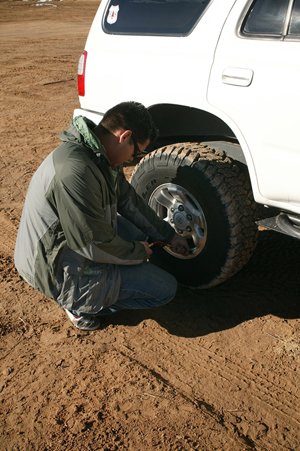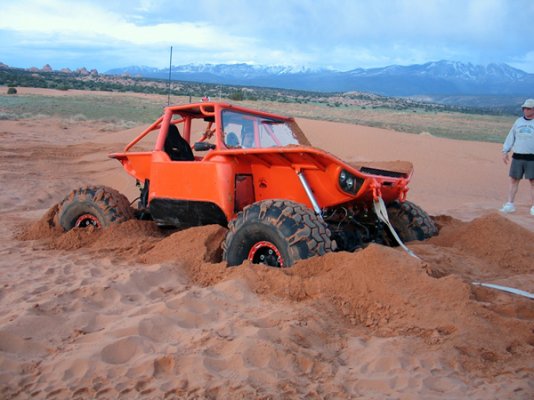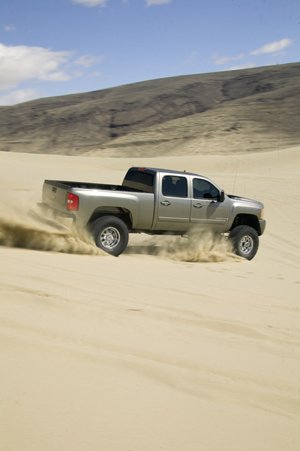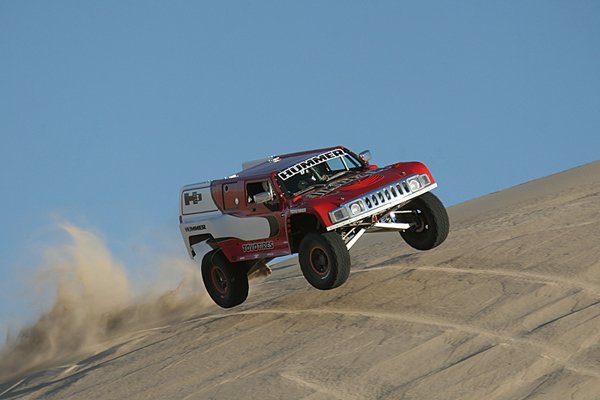KaiserM715
Kaiser Söze
Top Ten Sand Survival Tips
Top Ten Sand Survival Tips: Off-Road.com
Sand can be found from Glamis in Southern California to the Silver Lake dunes of Michigan. The beauty of sand is that you don’t necessarily need a built rig to enjoy it and there is less potential for damage than other terrain. That is assuming you keep all four tires on the ground. Air out your vehicle though and you might end up walking home.
While quads and sand rails outnumber 4x4s at the dunes, there are still advantages to having all four wheels spinning. There is no need for a tow rig and you can keep playing even when temperatures rise or the wind starts blowing. So follow along as Off-Road.com shows you how to make a fun day in the sand even more enjoyable.

Whip Antennas
Many OHV areas require a flag on the end of a whip antenna upon entry. Even in places where this is not required, a flag is still a good idea. The combination of limited visibility, low traction, and high speeds in the sand dunes can spell disaster in a hurry. A few dollars to make sure everyone can see you coming (and vise-versa) is cheap insurance.
Power to Weight Ratio
Sand dunes are rarely flat. Wind shapes and moves the dunes into a variety of slopes and sizes. Gravity is working against you as you try to climb these dunes, so it pays to keep your vehicle as light as possible. Note how well dune buggies work with simple and light air-cooled Volkswagen motors. They aren’t overly powerful but they are light enough to get away with the low power. High-end buggies with gobs of horsepower are virtually unstoppable. Heavier vehicles like fullsize trucks will need more power to travel the same places as lighter buggies and Jeeps. If you are near camp, you can leave your winch, Hi-Lift, ice chest, and spare tire at camp and travel fast and light with a tow strap and a few friends.

Airing down to increase floatation is always an important first step before entering the dunes.
Lower Air Pressure
Unlike mud or snow, there is no way you are ever going to get to the bottom of the sand. Floatation is key and you want to stay up on top of the sand. Lowering the air pressure on your tires will provide more floatation in the sand. When shopping for tires, a more mild tread pattern, such as an All-Terrain tire, will provide more floatation than a more aggressive tire, such as a Mud-Terrain (which tend to dig). Experiment with tire pressures as you want something low enough to float without having to worry about peeling the tire off the rim when carving through the dunes.
Recovery
Even with the perfect tire pressure, sooner or later you will find yourself buried to the framerails. There aren’t any rocks to stack in the dunes, or trees to winch from. This means that you have to have sturdy recovery points or you could be shoveling for a very long time. At a minimum, you should have tow points front and rear and a recovery strap. Travelling with a friend in another vehicle is also a good idea, so that someone can yank you out when you get stuck. If you are travelling to remote locations like Baja, consider equipping your vehicle with a winch for recovery. We have heard of people burying their spare tire in the sand to winch their vehicle out, but a better option is a Pull-Pal land anchor if you travel alone. Sand anchors are another option that take up a lot of space, but are popular overseas and can be invaluable at times.

Eventually you will get stuck so make sure to always have a tow strap and strong attaching points. Having a friend along to yank you out is also a major help.
Ability to Rev
Low end torque is great for towing but in the dunes it is more important to have an engine that can rev freely and keep the tires spinning. Small displacement engines and lightweight aluminum, short-stroke V8’s (like the Cadillac Northstar) are perfect for sand duty. Add forced induction like a turbocharger and the fun factor goes up even further. Just make certain to keep the internals clean with a good air filter and a pre-filter. Some grit in your turbo or engine can spell disaster in short order. Automatic transmissions are also beneficial in the sand, since manuals can cause you to lose momentum when you shift.

Staying on the gas to maintain momentum is important in the dunes. When you start to get bogged down make sure to turn down the dune to keep your vehicle moving.
Keep Momentum
Speaking of momentum, you want to do whatever you can to maintain it in the dunes. You need to go fast enough to keep from getting bogged down but slow enough to maintain control. Normally when your vehicle slows down, the natural response is to push the pedal further towards the floor. Do this in the sand though and you will find yourself with a shovel, or at least looking for someone to yank you out of the holes you dug (you do have those tow hooks and strap mentioned above, right?). Instead of spinning the tires, ease off the throttle and try to turn downhill if possible. Similarly, when coming to a stop just let off the gas. Hitting the brakes can cause sand to build up in front of the tires, making it harder to start again. Sand has a lot of resistance that will bring you to a stop quickly.
Watch The Temps
The rolling resistance of soft sand means that the drivetrain is fighting for every inch of forward progress. Add to this resistance the scorching heat that deserts are famous for and you have a recipe for disaster. You need to stay hydrated when you are in the desert, and so does your vehicle. That means a robust cooling system with an efficient radiator, high flow water pump, new coolant, and a high volume fan. Keep an eye on the temperatures at all times; sand can wreak havoc on cooling systems and torque convertors if left unchecked. If you have an automatic transmission, consider adding an aftermarket gauge and auxiliary cooler to keep the fluid cool.
Lots of Shock
More than ground clearance, more than approach angle, wheel travel and shock damping are critical in the dunes. The tires need to track the uneven terrain in order to maintain traction and control. They also need to do so over long periods of time and without beating you to a pulp. Remote reservoir shocks provide consistent damping with less temperature changes. Most high-end remote reservoir shocks also offer the ability to be rebuilt and valved to different specifications, so you can dial them in for your specific application. When pounding through the dunes, the best shocks you can afford are a worthwhile investment.

While you can still have fun in a solid axle vehicle, independent suspensions with gobs of travel allow you to haul some serious booty across the dunes.
Independent Front Suspension
Solid axles get a lot of attention in certain circles, but they are no match for independent front suspension (IFS) in the sand. The lower unsprung weight of IFS and the ability to soak up bumps at speed make independent suspension perfectly suited to the sand. Stock IFS suspensions have a reputation for being delicate though, so be certain not to exceed the operating range of the CVs with excessive droop or improper steering stops. Long travel suspensions and air bumps will allow you to travel through the dunes at much higher rates of speed and greater control and compliment your reservoir shocks.
Sand Paddles
When you step up to the big time, it is time for a set of paddles. Nothing roosts sand and pushes you back in your seat like a set of sand paddles. In fact, paddles can hook up on sand better than drag slicks at the strip. You aren’t just going to bolt these on to your stock SUV though. Paddles take huge horsepower to turn, so save them for the dedicated dune machine running big displacement, a turbo, nitrous, or all of the above.
Top Ten Sand Survival Tips: Off-Road.com
Sand can be found from Glamis in Southern California to the Silver Lake dunes of Michigan. The beauty of sand is that you don’t necessarily need a built rig to enjoy it and there is less potential for damage than other terrain. That is assuming you keep all four tires on the ground. Air out your vehicle though and you might end up walking home.
While quads and sand rails outnumber 4x4s at the dunes, there are still advantages to having all four wheels spinning. There is no need for a tow rig and you can keep playing even when temperatures rise or the wind starts blowing. So follow along as Off-Road.com shows you how to make a fun day in the sand even more enjoyable.

Whip Antennas
Many OHV areas require a flag on the end of a whip antenna upon entry. Even in places where this is not required, a flag is still a good idea. The combination of limited visibility, low traction, and high speeds in the sand dunes can spell disaster in a hurry. A few dollars to make sure everyone can see you coming (and vise-versa) is cheap insurance.
Power to Weight Ratio
Sand dunes are rarely flat. Wind shapes and moves the dunes into a variety of slopes and sizes. Gravity is working against you as you try to climb these dunes, so it pays to keep your vehicle as light as possible. Note how well dune buggies work with simple and light air-cooled Volkswagen motors. They aren’t overly powerful but they are light enough to get away with the low power. High-end buggies with gobs of horsepower are virtually unstoppable. Heavier vehicles like fullsize trucks will need more power to travel the same places as lighter buggies and Jeeps. If you are near camp, you can leave your winch, Hi-Lift, ice chest, and spare tire at camp and travel fast and light with a tow strap and a few friends.

Airing down to increase floatation is always an important first step before entering the dunes.
Lower Air Pressure
Unlike mud or snow, there is no way you are ever going to get to the bottom of the sand. Floatation is key and you want to stay up on top of the sand. Lowering the air pressure on your tires will provide more floatation in the sand. When shopping for tires, a more mild tread pattern, such as an All-Terrain tire, will provide more floatation than a more aggressive tire, such as a Mud-Terrain (which tend to dig). Experiment with tire pressures as you want something low enough to float without having to worry about peeling the tire off the rim when carving through the dunes.
Recovery
Even with the perfect tire pressure, sooner or later you will find yourself buried to the framerails. There aren’t any rocks to stack in the dunes, or trees to winch from. This means that you have to have sturdy recovery points or you could be shoveling for a very long time. At a minimum, you should have tow points front and rear and a recovery strap. Travelling with a friend in another vehicle is also a good idea, so that someone can yank you out when you get stuck. If you are travelling to remote locations like Baja, consider equipping your vehicle with a winch for recovery. We have heard of people burying their spare tire in the sand to winch their vehicle out, but a better option is a Pull-Pal land anchor if you travel alone. Sand anchors are another option that take up a lot of space, but are popular overseas and can be invaluable at times.

Eventually you will get stuck so make sure to always have a tow strap and strong attaching points. Having a friend along to yank you out is also a major help.
Ability to Rev
Low end torque is great for towing but in the dunes it is more important to have an engine that can rev freely and keep the tires spinning. Small displacement engines and lightweight aluminum, short-stroke V8’s (like the Cadillac Northstar) are perfect for sand duty. Add forced induction like a turbocharger and the fun factor goes up even further. Just make certain to keep the internals clean with a good air filter and a pre-filter. Some grit in your turbo or engine can spell disaster in short order. Automatic transmissions are also beneficial in the sand, since manuals can cause you to lose momentum when you shift.

Staying on the gas to maintain momentum is important in the dunes. When you start to get bogged down make sure to turn down the dune to keep your vehicle moving.
Keep Momentum
Speaking of momentum, you want to do whatever you can to maintain it in the dunes. You need to go fast enough to keep from getting bogged down but slow enough to maintain control. Normally when your vehicle slows down, the natural response is to push the pedal further towards the floor. Do this in the sand though and you will find yourself with a shovel, or at least looking for someone to yank you out of the holes you dug (you do have those tow hooks and strap mentioned above, right?). Instead of spinning the tires, ease off the throttle and try to turn downhill if possible. Similarly, when coming to a stop just let off the gas. Hitting the brakes can cause sand to build up in front of the tires, making it harder to start again. Sand has a lot of resistance that will bring you to a stop quickly.
Watch The Temps
The rolling resistance of soft sand means that the drivetrain is fighting for every inch of forward progress. Add to this resistance the scorching heat that deserts are famous for and you have a recipe for disaster. You need to stay hydrated when you are in the desert, and so does your vehicle. That means a robust cooling system with an efficient radiator, high flow water pump, new coolant, and a high volume fan. Keep an eye on the temperatures at all times; sand can wreak havoc on cooling systems and torque convertors if left unchecked. If you have an automatic transmission, consider adding an aftermarket gauge and auxiliary cooler to keep the fluid cool.
Lots of Shock
More than ground clearance, more than approach angle, wheel travel and shock damping are critical in the dunes. The tires need to track the uneven terrain in order to maintain traction and control. They also need to do so over long periods of time and without beating you to a pulp. Remote reservoir shocks provide consistent damping with less temperature changes. Most high-end remote reservoir shocks also offer the ability to be rebuilt and valved to different specifications, so you can dial them in for your specific application. When pounding through the dunes, the best shocks you can afford are a worthwhile investment.

While you can still have fun in a solid axle vehicle, independent suspensions with gobs of travel allow you to haul some serious booty across the dunes.
Independent Front Suspension
Solid axles get a lot of attention in certain circles, but they are no match for independent front suspension (IFS) in the sand. The lower unsprung weight of IFS and the ability to soak up bumps at speed make independent suspension perfectly suited to the sand. Stock IFS suspensions have a reputation for being delicate though, so be certain not to exceed the operating range of the CVs with excessive droop or improper steering stops. Long travel suspensions and air bumps will allow you to travel through the dunes at much higher rates of speed and greater control and compliment your reservoir shocks.
Sand Paddles
When you step up to the big time, it is time for a set of paddles. Nothing roosts sand and pushes you back in your seat like a set of sand paddles. In fact, paddles can hook up on sand better than drag slicks at the strip. You aren’t just going to bolt these on to your stock SUV though. Paddles take huge horsepower to turn, so save them for the dedicated dune machine running big displacement, a turbo, nitrous, or all of the above.
Last edited:




